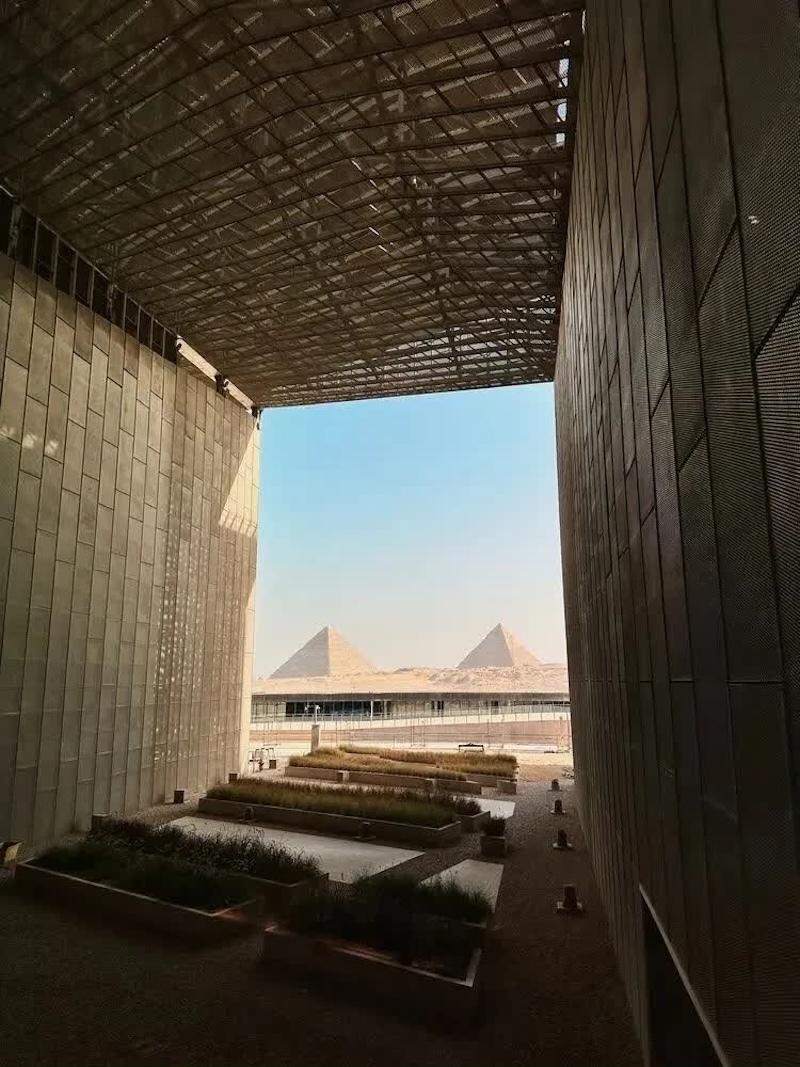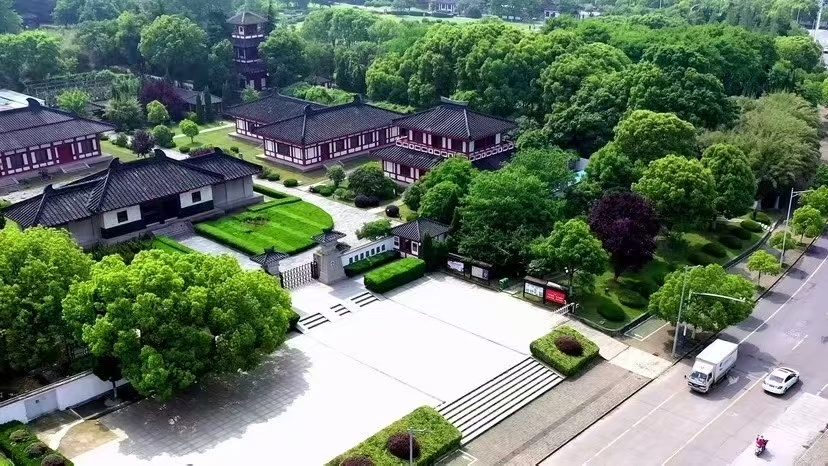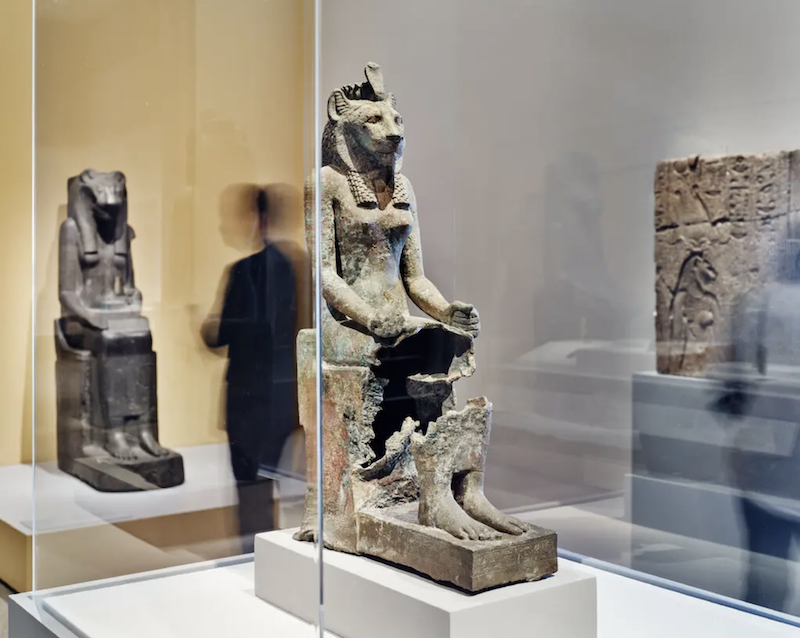
The Paper learned that the Grand Egyptian Museum, the world's largest museum dedicated to a single civilization, officially opened on November 1st local time after 20 years of construction and will fully open to the public on November 4th. This largest cultural project in Egypt, with its site selected in 2002 and construction commencing in 2005, represents a total investment of US$1.1 billion. Some exhibition halls opened last autumn. The museum now houses over 100,000 artifacts, including, for the first time, a complete and comprehensive display of over 5,000 funerary objects from Pharaoh Tutankhamun. Other exhibits include the restored Khufu Solar Boat and the Colossus of Ramses II.
At the opening ceremony, Egyptian President Abdel Fattah al-Sisi said, "This magnificent building is not only a place to preserve precious cultural relics, but also a vivid testament to the wisdom of the Egyptian people. It is this wisdom that enabled the Egyptian people to build the pyramids and etch immortal legends on the temple walls." Museum Director Ahmed Quneim said, "Its architecture is magnificent, as if it represents the fourth pyramid of Egypt."
In Egypt, behind modern daily life lies a visible bygone era: geometrically silent, towering, spired figures rise from the desert horizon, appearing and disappearing among apartment buildings. Beige upon beige, strikingly contrasting against the blue sky. These man-made wonders, dating back 4,500 years, evoke a sense of awe. Near the Giza pyramids, the Grand Egyptian Museum exudes majesty and order, setting it apart from the bustling, chaotic capital.

Grand Egyptian Museum
The Grand Egyptian Museum, with a total investment of US$1.1 billion and covering an area of approximately 500,000 square meters, is currently the world's largest archaeological museum dedicated to a single civilization. At the opening ceremony, Egyptian President Abdel Fattah al-Sisi unveiled the museum and delivered a speech. He stated that this is the world's largest museum dedicated to showcasing a single civilization (Egyptian civilization). This magnificent building is not only a place to preserve precious artifacts but also a vivid testament to the wisdom of the Egyptian people—the very wisdom that enabled them to build the pyramids and etch immortal legends onto the walls of their temples.

Grand Egyptian Museum
Like the nearby Great Pyramid of Giza, the Grand Egyptian Museum took nearly 20 years to build. Museum director Ahmed Ghunaim said, "The world will be amazed by the opening of the museum... its architecture is magnificent, as if it represents the fourth pyramid of Egypt."
In 1902, due to the inadequacy of the Egyptian Museum in downtown Cairo in terms of space and function to meet exhibition needs, the Egyptian government began constructing the Grand Egyptian Museum near the Giza Pyramids, about 5 kilometers southwest of Cairo, at the beginning of this century. However, it wasn't until January 2002 that the Egyptian government announced a global design competition to solicit designs for a brand-new museum complex. This museum would house, display, and preserve some of the world's greatest ancient treasures. The following month, the project site was selected just two kilometers from the Giza Pyramids in Cairo.

Egyptian Museum located in Tahrir Square, Cairo
In 2003, at a press conference in Cairo, the Irish-based Heneghan Peng Architects won a design competition to create a brand-new, highly modern "Grand Egyptian Museum." Construction officially began in 2005, but this ambitious project quickly encountered challenges from environmental, financial, and political fronts, leading to significant delays. It wasn't until 2014 that the project returned to normal, and construction was able to continue with the support of international loans.

In 2018, the granite statue of Ramses II was transported to the Grand Egyptian Museum.
The Egyptian government announced in 2018 and 2019 that the museum would open to the public. After the initial opening date was postponed, it was postponed again due to the global COVID-19 pandemic. The museum was then expected to fully open to the public in mid-2024, but this vision failed once more. The opening ceremony was subsequently postponed to July 3, 2025. However, in June, the Egyptian Prime Minister announced that due to the war between Israel and Iran, the full opening of the museum would be postponed until the fourth quarter of 2025. A statement from the Egyptian Ministry of Tourism and Antiquities stated: “This decision reflects Egypt’s sense of responsibility and its commitment to hosting a truly exceptional global event in an atmosphere befitting the magnificent heritage of ancient Egyptian civilization.”

View of the pyramids from the Grand Egyptian Museum
It is reported that the museum has a collection of more than 100,000 artifacts, and for the first time, it has fully and comprehensively displayed 5,992 funerary objects belonging to the ancient Egyptian Pharaoh Tutankhamun. In addition, it also exhibits artifacts such as the restored Khufu solar boat and the colossal statue of the ancient Egyptian Pharaoh Ramses II.
The Grand Egyptian Museum is a sleek, wedge-shaped building with a limestone facade covered in nested pyramid patterns, resembling an airport or shopping mall. Under the shade of palm trees, the museum staff in uniforms are full of energy, and golf carts carry tourists around.

Aerial view of the Grand Egyptian Museum

Grand Egyptian Museum
The Grand Egyptian Museum opened some of its galleries last autumn, with the Tutankhamun gallery being the highlight of the opening. November 4, 2025, marks the 103rd anniversary of the discovery of Tutankhamun's tomb and the official opening of the Grand Egyptian Museum to the public. This long-closed gallery will finally be unveiled.

The Grand Egyptian Museum will display all of Tutankhamun's funerary objects.
Tutankhamun ascended the Egyptian throne at the age of nine and died at nineteen, the cause of his death remaining a mystery to this day. His tomb is the only one in 3,300 years to have both his mummy and his treasures perfectly preserved. The fully open museum provides a place to display more than 5,000 treasures belonging to Pharaoh Tutankhamun. Some of these exhibits, which had been stored in warehouses since their excavation in the last century, are seeing the light of day for the first time.
Among the exhibits is Tutankhamun's most famous gold mask: when the archaeological team descended into the depths of the dusty tomb, Tutankhamun himself was found wearing this mask on his eternally sleeping face—it is inlaid with lapis lazuli and glass. Also on display are a gold throne depicting a sweet scene between him and his queen, childhood toys, painted boxes, embroidered gloves, six chariots, and ceremonial shields.

Solar Boat
The Solar Boat is another must-see exhibit for ancient Egypt enthusiasts. Excavated from the famous Great Pyramid of Giza, it is over 4,500 years old and still navigable. The ancient Egyptians believed this wooden boat could transport the pharaoh to the afterlife.

The granite statue of Ramses II in the Grand Egyptian Museum
The museum's interior space is astonishingly vast. The main atrium is so large it almost "swallows" its central exhibit—a statue of Ramses II. This 3,200-year-old, 11-meter-tall, 83-ton statue was discovered in fragments near ancient Memphis in 1820. This visual contrast reveals the dilemma faced by a contemporary "temple" when displaying ancient monuments: these artifacts were designed to overwhelm their surroundings—and indeed they did for centuries—and this overwhelming presence should not be diminished in a museum setting.
Fortunately, the museum's grand staircase successfully captures this tension. Vast in scale yet minimalist and restrained, its tiered design forms a stage, guiding visitors past statues, sarcophagi, and stelae as they ascend, as if climbing from antiquity. This fusion of ancient and modern is as natural as the Giza skyline. At the top of the staircase is a viewing platform offering panoramic views of the magnificent pyramids. The Grand Egyptian Museum is breathtaking through its sheer scale.

Looking towards the pyramids from the museum
The exhibition halls are an open space arranged along the same slope as the grand staircase, allowing visitors to descend naturally and proceed in roughly chronological order from prehistoric times to the Greco-Roman period, traversing the Middle and New Kingdoms. Each era is further divided into three vertical themes: "Society," "Royalty," and "Belief," comprising a total of 12 exhibition halls.

Grand Egyptian Museum exhibition hall

Grand Egyptian Museum exhibition hall
Faced with Egypt's dazzling array of pottery, coffins, figurines, and hieroglyphic artifacts, visitors can easily feel overwhelmed by information. However, thanks to meticulous curation, these artifacts are arranged into carefully constructed visual units, which, while slightly symmetrical in form, are captivating enough. Large transparent display cases layer adjacent exhibits, creating rich visual relationships. One highlight is a set of 40 miniature wooden soldier models, unearthed from the tomb of Mesehti, a local governor, at the end of the First Intermediate Period (c. 2181–2055 BC, approximately 100 years during the Old and Middle Kingdoms). These funerary objects, intended to protect the deceased in the afterlife, offer a rare glimpse into the lives of ordinary members of society at that time. The soldiers, with their neatly short hair, wielding spears and shields, and wearing kilts for ease of movement, stand in elegant contrast to the solemn black sarcophagus beside them.

This set of ancient Egyptian soldier models was unearthed from a tomb in Mesehti.
The exhibition hall has no fixed route, presenting a rare "non-educational" experience. While the textual explanations on the walls may be somewhat brief, they always attempt to imbue the exhibits with a "human" dimension, whenever possible. For example, a cracked wooden mallet sits beside an unfinished, somewhat rough statue, evoking images of ancient craftsmen who once wielded tools and worked day after day. Fragmented papyrus manuscripts are usually difficult to decipher, but in the Grand Egyptian Museum, they are displayed alongside a set of scribe's tools—an inkwell, ink reservoir, and polishing tool for fixing pigments—a still life that silently tells the story of the ancient writers' skills and daily lives.

Grand Egyptian Museum exhibition hall
At the opening ceremony, Director Ahmed Quneim stated, "As our President said, the Grand Egyptian Museum is Egypt's gift to the world. It has transformed the landscape of Egypt's tourism industry and promoted the development of cultural tourism, which is of great importance. At the same time, a new airport has been built near the museum, and hotels and leisure facilities have been added, welcoming overseas tourists to visit the ancient Egyptian civilization."
The Grand Egyptian Museum officially opened to the public on November 4.
(Some content in this article is compiled from the museum's official website and previous reports by The Paper.)


